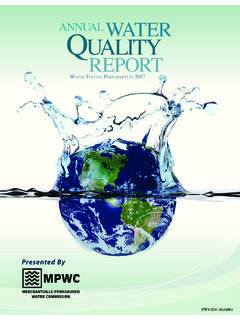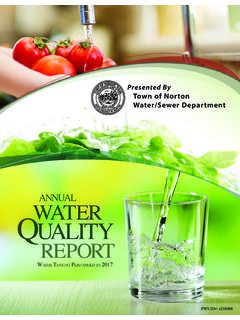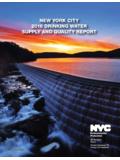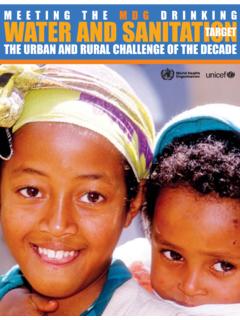Transcription of annual QWater uality REPORT - gemgrp.com
1 water testing Performed in 2016 WaterREPORTQ ualityannualPWS ID#: 3503549 Este informe contiene informaci n muy importante sobre su agua potable. Trad zcalo o hable con alguien que lo entienda ByImportant Health InformationSome people may be more vulnerable to disease causing microorganisms or pathogens in drinking water than the general population. Immuno-compromised persons such as persons with cancer undergoing chemotherapy, persons who have undergone organ transplants, people with HIV/AIDS or other immune system disorders, some elderly, and infants can be particularly at risk from infections.
2 These people should seek advice from their health care provider about their drinking water . EPA/CDC guidelines on appropriate means to lessen the risk of infection by Cryptosporidium, Giardia and other microbial pathogens are available from the Safe drinking water Hotline at (800) present, elevated levels of lead can cause serious health problems, especially for pregnant women, infants, and young children. It is possible that lead levels at your home may be higher than at other homes in the community as a result of materials used in your home s are responsible for providing high quality drinking water , but cannot control the variety of materials used in plumbing components.
3 When your water has been sitting for several hours, you can minimize the potential for lead exposure by flushing your tap for 30 seconds to 2 minutes before using water for drinking or cooking. If you are concerned about lead in your water , you may wish to have your water tested. Information on lead in drinking water , testing methods, and steps you can take to minimize exposure is available from the Safe drinking water Hotline (800) 426-4791 or at ve Come a Long WayOnce again we are proud to present our annual water quality REPORT covering the period between January 1 and December 31, 2016.
4 In a matter of only a few decades, drinking water has become exponentially safer and more reliable than at any other point in human history. Our exceptional staff continues to work hard every day at any hour to deliver the highest quality drinking water without interruption. Although the challenges ahead are many, we feel that by relentlessly investing in customer outreach and education, new treatment technologies, system upgrades, and training, the payoff will be reliable, high-quality tap water delivered to you and your ParticipationYou are invited to participate in our public forum and voice your concerns about your drinking water .
5 We meet the 2nd and 4th Mondays of each month, except in July and August when there is only one meeting. Meetings take place at 7 in the Council Chambers at City Hall, 83 Broadway, Newburgh, New York. For more information concerning City Council meetings, contact the Executive Office at (845) 569-7301. There is always an open forum to express your opinions and ideas. Visit the website at That Could Be in WaterThe sources of drinking water (both tap water and bottled water ) include rivers, lakes, streams, ponds, reservoirs, springs, and wells.
6 As water travels over the surface of the land or through the ground, it dissolves naturally occurring minerals and, in some cases, radioactive material, and can pick up substances resulting from the presence of animals or from human activities. Contaminants that may be present in source water include: Microbial Contaminants; Inorganic Contaminants; Pesticides and Herbicides; Organic Chemical Contaminants; and Radioactive water , including bottled water , may reasonably be expected to contain at least small amounts of some contaminants.
7 The presence of contaminants does not necessarily indicate that water poses a health risk. In order to ensure that tap water is safe to drink, the State and the EPA prescribe regulations which limit the amount of certain contaminants in water provided by public water systems. The State Health Department s and the FDA s regulations establish limits for contaminants in bottled water which must provide the same protection for public health. More information about contaminants and potential health effects can be obtained by calling the EPA s Safe drinking water Hotline at (800) Does My water Come From?
8 Our water source originates from the Washington Lake and the Silver Stream these two sources are not available, the tap on the NYC Catskill Aqueduct can be used as an emergency supply. The City of Newburgh water Department is currently one of our emergency sources of water , which is the NYC Catskill Aqueduct. The water quality of these supplies is excellent and meets all New York State Department of Health (NYS DOH) Is My water Treated and Purified?After the water is withdrawn from the reservoir or aqueduct, this water undergoes several chemical and physical processes to ensure that potential contaminants are removed and the water is clean and safe for your needs prior to distribution.
9 The City s water filtration plant has the ability to treat approximately 9 million gallons of water per day, more than two times our average daily consumption. The plant also uses a series of mechanical and chemical treatments to remove color, odor, and tastes, along with organic material, dirt, and particles. The water then passes through a series of sand filters; chlorine is added for disinfection; fluoride is added to help promote sound dental health; and corrosion inhibitors are added to reduce the corrosive effects of water on pipes and plumbing.
10 The water is then pumped to underground and above-ground storage tanks and into your home or water AssessmentThe NYS DOH has evaluated our susceptibility to contamination under the Source water Assessment Program (SWAP), and their findings are summarized in the paragraph below. These assessments were created using available information; they estimate only the potential for source water contamination. Elevated susceptibility ratings do not mean that source water contamination has or will occur. We provide treatment and regular monitoring to ensure that the water delivered to customers meets all applicable analysis of available information for this source water assessment did not find any significant sources of contamination in the watershed.









